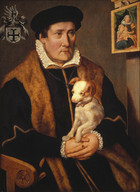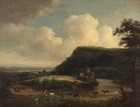News:
Netherlands Returns Two Paintings Looted by Hermann Goering to Jewish Heir
By Catherine Hickley
The Dutch government said today it will return two paintings that were looted more than 70 years ago by Reichsmarschall Hermann Goering for his country estate to the descendants of a Jewish antiques dealer in Paris.

The anonymous 16th-century painting, "Portrait of a Man With a Dog,'' will be returned by the Dutch government to the heirs of a Jewish antiques dealer who survived the Nazi occupation of Paris. The painting was looted by Hermann Goering for his country estate. Source: Dutch Restitutions Committee via Bloomberg
Edouard Leon Jonas shipped the contents of his Paris antiques store to Bordeaux for safekeeping after the 1940 Nazi invasion. One of Goering’s art advisers seized them and sent them to Germany. Among them were an anonymous 16th-century oil- on-wood “Portrait of a Man With a Dog,” and Theobald Michau’s 18th-century “Landscape With Cattle in a Shallow River.”
The Dutch Restitutions Committee, which advises the government on Nazi-era art claims, recommended the paintings be returned to Jonas’s heirs, whom it didn’t name. It said the heirs’ title to the paintings is “proved with a high degree of probability” and “possession of them was lost involuntarily due to circumstances directly related to the Nazi regime.”

``Landscape With Cattle in a Shallow River'' by Theobald Michau was looted by Hermann Goering for his private collection. Goering later included the picture in a batch of 140 artworks that he exchanged for one painting he believed was a Vermeer and later turned out to be a forgery. Source: Dutch Restitutions Committee via Bloomberg
Goering stashed as many as 1,800 artworks at Carinhall, his country home outside Berlin, many of them stolen from French Jewish families. About 80 percent of his loot -- most of which was safely evacuated before his home was bombed -- has since been traced and returned to the rightful owners, according to Nancy Yeide, author of a comprehensive catalog of Goering’s art.
He deluded himself that he wasn’t stealing. “During a war, everybody loots a little bit,” he said in an interview with a psychiatrist in Nuremberg, where he was convicted of crimes against humanity after the war and committed suicide before he was to be executed. “None of my so-called looting was illegal.”
Duped by Forgery
The Dutch Restitutions Committee said the two claimed paintings also featured on a list of 140 works that Goering forfeited in his fervor to get hold of a work by Johannes Vermeer. He traded them in 1944 for what he believed would be the jewel in his collection, a Vermeer called “Christ and the Adulteress.”
It later turned out to be the work of master forger Han van Meegeren. As a result of that ill-advised exchange, the two paintings found their way to the Amsterdam dealership that had traded with Goering, Goudstikker-Miedl. After the war, they entered the Netherlands National Art Collection. One was housed in a government depot; the other was on loan to a museum in Maastricht.
The Netherlands was one of 44 countries that, in 1998, endorsed international principles on returning art stolen from the mainly Jewish collectors who were victims of Adolf Hitler’s regime. To implement the guidelines, the Dutch government founded a Restitutions Committee in 2002. The panel since has made recommendations on 107 claims for art in state hands.


